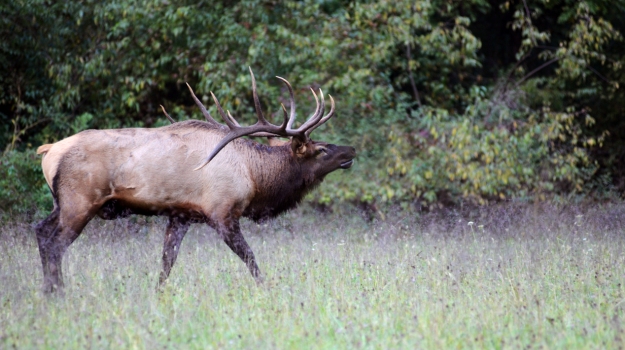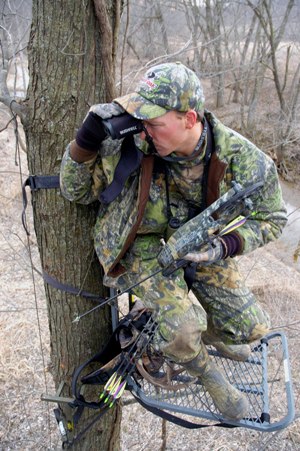
Editor’s Note: Dennis Garrett of Harlan, Kentucky, in the southeastern corner of the state, lives in the Appalachian Mountains and says, “I've worn Mossy Oak from the first time I started hunting. I've been deer hunting since 1998, but my dad took me squirrel hunting with him when I was too small to carry a gun. I like the Mossy Oak Treestand pattern. When the leaves are off the trees in our section of the country, our trees look gray, and then I’ll resemble a part of the tree. During the early hunting season, I like Mossy Oak Infinity.”
Not only do I wear Mossy Oak to camouflage me from the animals, I also use Mossy Oak in the cover of darkness to keep other hunters from seeing where I hunt. If I get off work at 3:00 pm and reach home by 4:00 pm, I can hunt until dark and then come out of the woods after dark. On weekends, I go into the woods before daylight and don’t come out until after dark. I don’t want the deer to see me, and I don’t want other hunters to know where I'm hunting. A good spot to consistently take nice bucks is very hard to find, to get permission to hunt there and to do the work required, so the landowner will continue to let you hunt there. I've found that no one else knowing where you're hunting is just as important as finding a great place to hunt.
Generally I don’t use a flashlight or a GPS receiver to get from where I leave my vehicle until I reach my stand site, because there's usually only one small path in to my stand site and out. However, if I'm hunting on flat ground, I may get lost. Then I’ll use my GPS to help me to return to my vehicle. I know the mountains around my home well - like the back of my hand. The only problem with walking in the dark without a flashlight is that our region does have a really healthy bear population.
Southeastern Kentucky also homes the largest elk herd east of the Mississippi River. I put in every year for a tag, but I still haven’t been drawn to have an opportunity to take one of these elk. In the afternoons, I’ll often load up my children and take them to some of the reclaimed strip mine land to let them watch the elk. My children have been able to watch 6x6 bulls bugle at less than 60-yards from them.
 I guess the bear numbers have been increasing by feeding on the elk and deer. Last year was our first archery season on bear. The state only allows a harvest of 10 bears. After 10 bears have been checked in, the season is closed. I check every night at 9:00 pm to see if bear season is open. I've been working part-time at the bow shop Mountain Outdoors in Baxter, Kentucky, owned by Brett Turner. Mountain Outdoors is a check-in station, and state biologists and conservation officers are in the shop regularly. When a bear comes in to be checked-in, these state people take blood samples to get DNA. They also pull a tooth and a claw from each bear, besides taking tons of photographs of the bears. Although the biggest bear taken from our county weighed a little over 500 pounds, most of the bears checked in here will weigh from 200 to 250 pounds. The season’s usually in December when most of the females bear are denned-up. Archery bear season usually runs for 10 days or until 10 bears are taken. Then gun season starts and runs for 10 days or until 10 bears are taken with guns.
I guess the bear numbers have been increasing by feeding on the elk and deer. Last year was our first archery season on bear. The state only allows a harvest of 10 bears. After 10 bears have been checked in, the season is closed. I check every night at 9:00 pm to see if bear season is open. I've been working part-time at the bow shop Mountain Outdoors in Baxter, Kentucky, owned by Brett Turner. Mountain Outdoors is a check-in station, and state biologists and conservation officers are in the shop regularly. When a bear comes in to be checked-in, these state people take blood samples to get DNA. They also pull a tooth and a claw from each bear, besides taking tons of photographs of the bears. Although the biggest bear taken from our county weighed a little over 500 pounds, most of the bears checked in here will weigh from 200 to 250 pounds. The season’s usually in December when most of the females bear are denned-up. Archery bear season usually runs for 10 days or until 10 bears are taken. Then gun season starts and runs for 10 days or until 10 bears are taken with guns.
Kentucky offers several hundred elk tags each year. But since I haven’t been drawn yet to take an elk, that’s why I concentrate my hunting on whitetails. I may see bears, and I usually see elk anytime I want to see them, but getting a tag to hunt them hasn’t been easy.
In the wildlife zone that I hunt in - Zone 4 – I can take one buck and three does per season. I struck out last season. I hunted the entire bow season before gun season arrived, hoping to take a doe. My family loves to eat venison. But during the entire archery season, I never saw a doe. When gun season came in, I had four does under my tree stand. One doe bedded-down within easy bow range, but we’re not permitted to take does during Kentucky’s gun season.
I had a really weird hunting season last season. I passed-up two good bucks, because I was waiting on one buck I’d found that was an absolute giant. I'd hunted that big buck for 3 years. Usually when I didn’t see him, I’d take a smaller buck. But last year, I made the decision that I wouldn’t take a smaller buck and was going to hold out for the big buck. Although I had two opportunities to take him, I couldn’t get a shot at him. I have three years’ worth of trail-camera photos of this buck that will score in the 170s. One of the neighbors to the property I hunt saw the big deer coming through his backyard and told me, “He’s an 11-pointer this year - a true monster.” So, I'm hoping I’ll get a shot at him this season.
Day 1: How to Find the Best Hunting Spots Where You Live and Get Permission to Hunt
Tomorrow: Dennis Garrett Says in Southeastern Kentucky Any Bow Buck Is a Good Buck



























